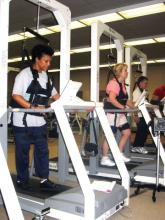Results from a randomized trial show that low-intensity treadmill exercise leads to more consistent improvements in the gait and mobility of patients with Parkinson’s disease than does high-intensity treadmill exercise or stretching and resistance exercise.
However, only patients who participated in stretching and resistance exercise experienced significant improvements in the motor component of the Unified Parkinson’s Disease Rating Scale (UPDRS).
"There isn’t a neurologist who cares for patients with Parkinson’s that doesn’t have their patients ask them, ‘What should I do to help myself? What kind of exercise, if any, should I do?’ " Dr. Lisa M. Shulman said in an interview in advance of the annual meeting of the American Academy of Neurology, where the research was presented. "We haven’t had a good answer to that question for years. This study is a good start in terms of telling patients what they can do to help themselves. I’ve begun to tell my patients that they should do a combination of low-intensity treadmill exercise and stretching resistance training to get the range of benefits that we demonstrated in our study."
Dr. Shulman, a professor of neurology at the University of Maryland, Baltimore, and her associates enrolled 67 Parkinson’s patients who had trouble walking into one of three groups: high-intensity treadmill (30 minutes at 70%-80% heart rate reserve); low-intensity treadmill (50 minutes at 40%-50% heart rate reserve); or stretching and resistance exercises (two sets of 10 repetitions of leg presses, extensions, and curls performed on exercise machines). The study participants exercised three times a week for 3 months and were supervised by exercise physiologists at the Baltimore Veterans Affairs Medical Center.
Baseline pre- and posttraining measures included the 6-minute walk; 10-meter and 50-foot gait speeds; peak oxygen consumption; and the UPDRS, which evaluates disease symptoms such as tremor, rigidity, loss of dexterity, slowness, walking, and balance.
The mean age of patients was 66 years and 75% were male. Dr. Shulman reported that at the end of 3 months, all modes of exercise improved distance on the 6-minute walk, with significant improvements in the low-intensity treadmill group and in the stretching/resistance group, and a trend toward significance in the high-intensity treadmill group. The greatest improvement was seen in the low-intensity treadmill group, in which patients walked 11% further over 6 minutes, a distance equivalent to half a city block.
Both treadmill groups significantly improved their 10-meter fast gait, but the low-intensity treadmill group demonstrated greater improvement on the 50-foot fast gait. Both treadmill groups improved peak oxygen consumption.
Only patients in the stretching/resistance group experienced significant improvements in the motor component of the UPDRS, the key measure of Parkinsonian motor symptoms.
"The fact that the low-intensity treadmill group had more consistent benefit in terms of gait and mobility was surprising," Dr. Shulman said. "Our main interest was improvement in gait and mobility, because those are the most disabling symptoms of Parkinson’s disease. A key fact is that it wasn’t necessary to greatly increase the intensity of walking to achieve benefit. That means that more people with a greater range of disability can benefit from exercise in Parkinson’s disease."
The positive impact of stretching and resistance exercise was also surprising, she said. "People with Parkinson’s who have rigidity tend to develop a stooped posture; they tend to lose their range of motion and general mobility because they’re stiff and slow," Dr. Shulman said. "One possibility is that the stretching and strengthening exercises in that group relieved symptoms of loss of range of motion and stiffness over time."
She acknowledged certain limitations of the study, including the fact that outcomes were evaluated only at 90 days and that it was a single-blinded (not a double-blinded) analysis. "There isn’t any way to get around that, since patients in exercise trials are aware of their exercise training," she noted. "It’s ironic that all of our patients were hoping that they would be assigned to the high-intensity treadmill group. They all wanted to be in that group because it was clearly the most strenuous group. When they were assigned to the low-intensity group or to the stretching/resistance group, they were somewhat disappointed, yet those were precisely the groups that were most effective."
The study was funded by the Michael J. Fox Foundation for Parkinson’s Research, the VA Center of Excellence in Exercise and Robotics for Neurological Disorders, and the Baltimore VA Medical Center’s Geriatric Research, Education, and Clinical Center.



